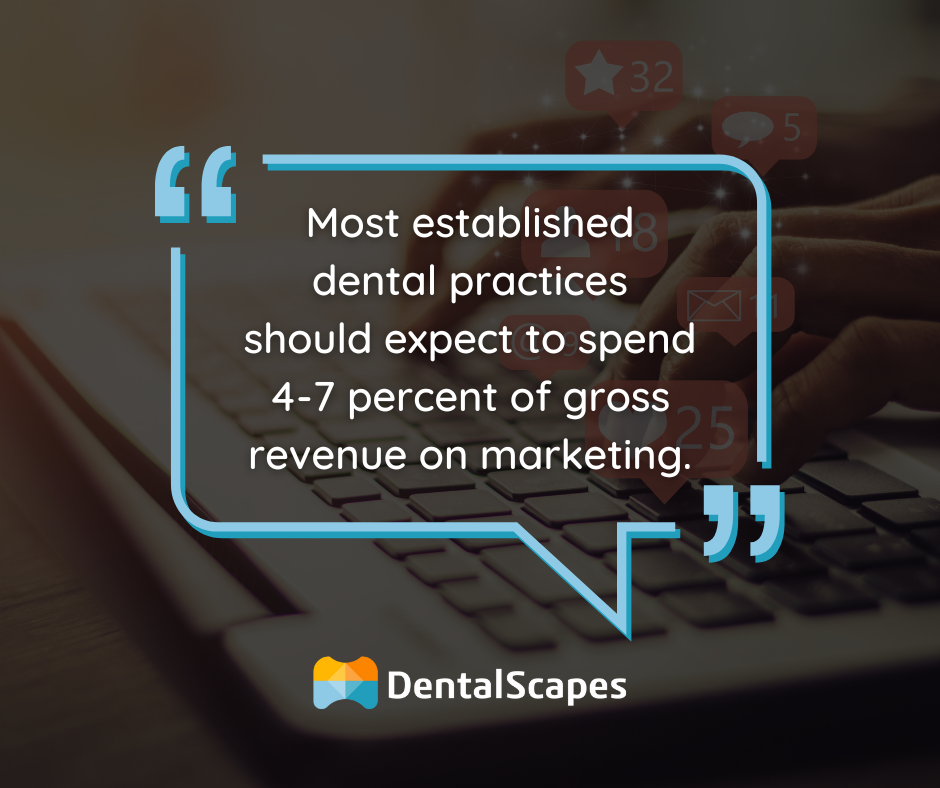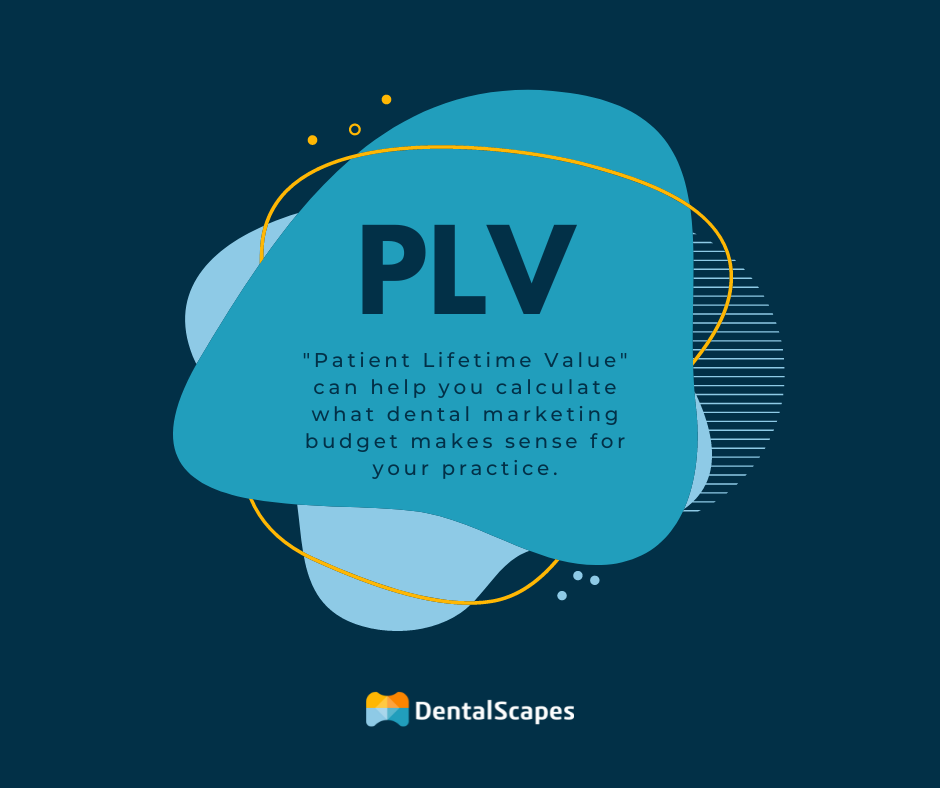How Much Should a Dental Practice Spend on Marketing?
Dentists spend a lot of money on staffing, equipment, materials, office space, and more. But what about marketing? The amount of money spent by dental practices on marketing ranges greatly based on practice type, age, location, competition, and specific objectives. Nevertheless, most established dental practices should expect to spend 4-7 percent of gross revenue on marketing.

This amount includes costs associated with both traditional marketing (e.g., print media, direct mail, radio, etc.) and digital marketing (e.g., website design, SEO, PPC, social media marketing, and more).
Based on this benchmark, an established dental practice generating $1,000,000 in annual revenue would spend $40,000-70,000 per year on marketing, or $3,333-5,833 per month. An established dental practice generating $2,000,000 in annual revenue would spend $80,000-140,000 per year, or $6,666-11,666 per month.
So, how much should dentists spend on marketing to get new patients?
The best anwer, as with many issues in dentistry, is that it depends.
In this blog post, we’ll be outlining some of the factors that influence what dental practices spend on marketing — and what factors might inform your own marketing budget.
New vs. Established Practices
Keep in mind that, in general, marketing costs for dental practices will be higher for newer practices that have not yet established a reputation in the community or a significant patient base for referrals. In general, new dental practices should expect to spend between 15 and 25 percent of gross revenue on marketing.
But but but…. that initial investment in marketing should scale down as patient volume (and corresponding referrals) increases.
What is Included in a Marketing Budget for a Dental Practice?
Your dental practice’s marketing budget includes all costs associated with activities designed to promote your practice and acquire new patients (across all marketing channels). You can divide these dental marketing costs into two buckets: traditional (“offline”) marketing and online marketing, often called digital marketing.
Traditional Marketing
Any “offline” activities designed to promote your practice fall within the “traditional” marketing budget for your dentist office. Costs may include, but are not limited to:
- Print advertisements (e.g., newspaper and magazine ads, flyers, etc.)
- Direct mail campaigns (e.g., postcards)
- Billboards
- Radio and TV advertising
- Public relations and media relations
Online Marketing
Online marketing, as the name suggests, covers any activities designed to promote your practice and acquire new patients on the internet. This is often referred to as “digital marketing,” and includes costs such as:
- Website design and development
- Search engine optimization (SEO)
- Pay-per-click (PPC) advertising
- Social media marketing
- Review campaigns
- Email marketing
How to Calculate a Dental Marketing Budget
Not sure where to spend money to acquire new patients for your dental practice? Consider your objectives first. How many new patient appointments do you need to hit your revenue goals? How many new patients per month do you need to cover your marketing costs?
You’ll first want to calculate your average new patient appointment value.
From there, you can factor in the average patient lifetime value (PLV) and determine the dentist marketing budget that makes sense for your practice.
Average New Patient Appointment Value
Not all new patients will require the same services. So your average new patient appointment value should be exactly that — an average. For many practices, this will be the total patient cost of an initial exam, x-rays, and cleaning. Let’s say this adds up to $200. In this scenario, you’ll want to spend no more than $200 on marketing to acquire a new patient — at least if your goal is to break even (more on that in a moment).
So, if you’re looking to add 25 new patients per month, you might consider a marketing budget of up to $5,000 per month.
Average Patient Lifetime Value (PLV)
When it comes to acquiring new patients through marketing (online or offline), most dentists want to at least break even. But if you want to build a profitable practice, that may not be the best outlook.
Because what happens when you factor in the lifetime value of a new patient? With patient lifetime value (PLV) in play, suddenly a short-term loss on marketing might look more appealing.

For example, imagine that a new patient spends $200 on their first appointment, but over the course of the next 5 years, spends $4,000 on dental care at your practice (a relatively conservative estimate, depending on your type of practice). Even if you spent $200 to acquire that patient and only broke even on the initial appointment, you’d still generate a 2,000% return on investment (ROI) on your marketing spend. And that’s only forecasting the next 5 years! Imagine the ROI associated with a longer-term patient.
By including PLV in your calculations, you may find that breaking even — or even taking a loss — on the first appointment will more than justify a larger dental marketing budget.
How Do Marketing Budgets for Dentists Compare to Other Businesses?
Dental marketing budgets are often greater than marketing budgets for other types of businesses. That’s generally because competition among dentists is fierce, which drives up advertising costs. Business-to-consumer (B2C) companies also typically spend more on marketing than business-to-business (B2B) companies.
Nevertheless, according to a 2023 survey by WebStrategies, on average, B2C businesses are spending 8.4% of revenue on marketing. By this benchmark, the 4-7% of revenue typically spent by dentists on marketing seems reasonable.
As a quick reminder, remember that the percentage of revenue spent on marketing should be higher for a new dental practice than an existing practice with an established base of patients. While 4-7% of revenue may be an effective marketing spend for most established dentists, a new practice may need to spend significantly more than that (maybe 15-25% of revenue) to grow at the outset.
What Should Dental Practices Budget for Dental Marketing?
While industry comparisons are helpful, your dental marketing budget will ultimately be determined by your unique objectives and the business fundamentals of your practice. Depending on overhead and cash flow, not every established dentist can afford to spend 4-7% of revenue on marketing. You should work with your dental marketing company to determine a digital marketing budget (and traditional marketing budget) that will both support your objectives and fit your practice’s current business performance.
At DentalScapes, we combine an analysis of client business expenses and performance metrics to determine recommended spend for dental marketing tactics. From dental SEO to dental website design and more, book a free discovery call with us and let’s see how we can help.
What Metrics Matter When Budgeting for Dental Marketing?
There are many metrics that should be considered when determining your dental practice marketing budget. Among these are:
New Patient Appointment Value
New patient appointment value is the average revenue associated with — you guessed it — a new patient appointment. For many dental practices, this might be the total cost (to the patient or insurance carrier) of an initial exam, x-rays, and cleaning.
Patient Lifetime Value (PLV)
Patient lifetime value (PLV) refers to revenue generated over the lifespan of the patient (or at least the time with which they’re at your practice). This value can range widely, so it may be more helpful to calculate average patient value for a more limited timespan, such as a 3-year average PLV or 5-year average PLV. Calculating patient lifetime value can help determine your dental marketing budget based on an anticipated return on investment (ROI).
Cost-per-Click (CPC)
If your dental practice is running PPC ads for dentists, your average cost-per-click will help inform your cost-per-lead (see below) and other important metrics that can be used when determining the right dental marketing budget. Cost-per-click is exactly that — the amount your practice pays for a click on one of its PPC ads (often on Google or Facebook). Depending on your market, CPC may range anywhere from $5 to $20 or more (give or take). Keep in mind, however, that higher CPCs may still be worthwhile if your dentist office is converting clicks into phone calls and form fills at a decent rate (e.g., 50+ percent).
Cost-per-Lead (CPL)
Cost-per-lead, or CPL, refers to the amount your dental practice pays for a qualified phone call or form fill. To be clear, a lead is not a new patient, but a potential patient who has signaled interest in making an appointment by contacting your office. CPL ranges widely by practice area and location, but acceptable limits (and, by extension, dentist marketing budgets) should be determined based on the conversion rate (i.e., the number of leads that convert into actual patients), average new patient appointment value, and patient lifetime value.
Cost-per-Acquisition (CPA)
Maybe the most important of all marketing metrics, cost-per-acquisition, or CPA, measures the amount a dentist office spends per new patient appointment. To calculate CPA, simply take your marketing spend and divide it by the number of new patients. Your dental practice CPA can be used to help inform future marketing budget. For instance, if your CPA is $50, you can calculate that the marketing investment needed to generate 20 new patient appointments should be roughly $1,000.
How Much Do Dental Marketing Services Cost Each Month?
There are thousands of marketing agencies offering traditional and online marketing services to bring in new patients for dentists. Among these, dental marketing costs vary widely. While some dental marketing companies profess to offer “comprehensive” or “all-in-one” digital marketing services for as little as $200 per month (proceed with caution), other agencies may offer a single service like SEO or PPC for more than $1,000 per month. Dentist web design, in particular, varies greatly in price, with agencies charging from $500 to $15,000+ per project.
Estimated Ranges for Dental Marketing Services
From local SEO to PPC, social media advertising to reviews, and everything in between, what you’ll pay for dental marketing services varies greatly by agency experience, practice type, age, location, competition, and other factors. Here are estimated ranges for a variety of common dentist marketing strategies:
- Web design — $500-15,000 per dentist website (one-time fee)
- SEO — $100-2,500 per month
- PPC — $250-2,500 (flat fee) or 10-20% (of ad spend) per month
- Social media marketing — $100-1,500 per month (1-3 social media channels)
- Review campaigns — $100-1,000 per month
- Email marketing — $100-1,000 per month
As unsatisfactory as it may sound, the standard business axiom applies: in most cases with dental marketing, you get what you pay for. Not many “all-in-one” marketing packages will provide the type of SEO needed to dominate the 1st page of Google, nor will they generate the best ROI on pay-per-click (PPC) marketing. The same is true of website design and other services.
Be especially wary of any dental marketing agency that wants to retain ownership of your practice’s digital assets. You should always maintain control of your website, ad account(s), social media account(s), and other online marketing platforms. At our dental marketing agency, for instance, all content and digital assets created for a client remain theirs in perpetuity, no matter what.
Need a Marketing Strategy for Your Dental Practice?
At DentalScapes, we specialize in developing high-impact, cost-effective marketing programs that increase traffic, generate leads, and drive new patient appointments for small to mid-size dental offices.
From dental websites to search engine marketing (SEO), Google ads to content marketing, and everything in between, we’re ready to help your practice put patients in the chair and maximize profitability. Book a free discovery call today to learn more, and let’s see how we can help!
